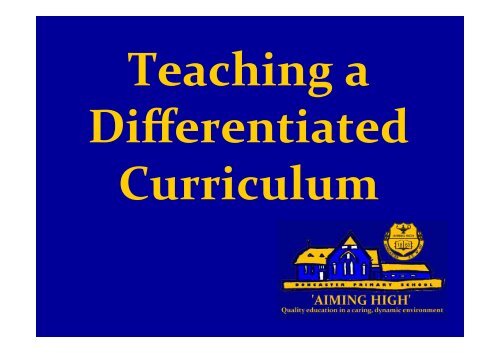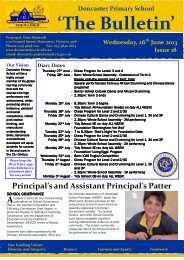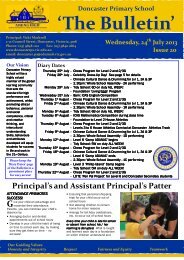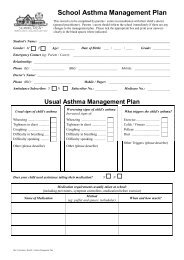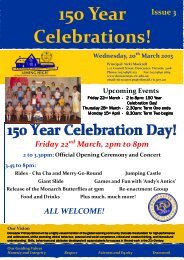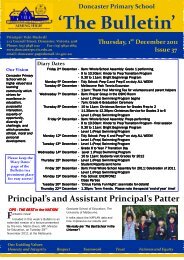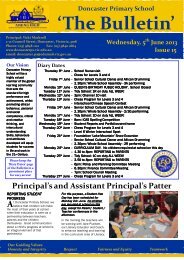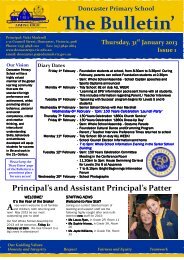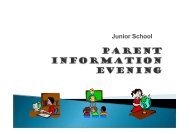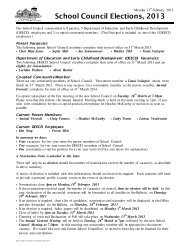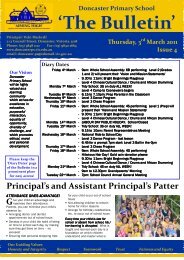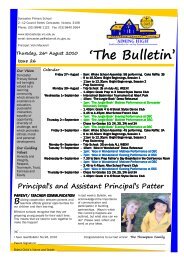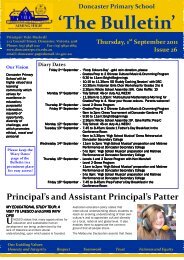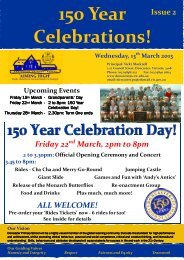Teaching a Differentiated Curriculum at DPS
Teaching a Differentiated Curriculum at DPS
Teaching a Differentiated Curriculum at DPS
Create successful ePaper yourself
Turn your PDF publications into a flip-book with our unique Google optimized e-Paper software.
<strong>Teaching</strong> a<br />
<strong>Differenti<strong>at</strong>ed</strong><br />
<strong>Curriculum</strong>
Teachers cre<strong>at</strong>e a classroom /<br />
learning environment in which they<br />
are responding to the learning<br />
needs of your child, r<strong>at</strong>her than<br />
teaching the class as though all<br />
individuals are alike.
Learner variance means th<strong>at</strong><br />
teachers do not assume th<strong>at</strong> every<br />
student begins and ends a task <strong>at</strong><br />
the same time.
In other words, teachers lead a<br />
differenti<strong>at</strong>ed classroom.<br />
Wh<strong>at</strong> does this mean to you?
Children have developmental<br />
and experiential differences,<br />
therefore, not all children have<br />
the same zones of proximal<br />
development in rel<strong>at</strong>ion to skill<br />
and understanding.
Each child’s learning goals need to be<br />
understood – time, m<strong>at</strong>erials, modes of<br />
teaching, ways of grouping, expressing<br />
and assessing learning will be different.
Student differences are expected,<br />
appreci<strong>at</strong>ed and studied by teachers as a<br />
basis for instructional planning. There<br />
is a clear bond th<strong>at</strong> exists between<br />
assessment and instruction.
In other words, the teacher sees<br />
everything a child says or cre<strong>at</strong>es as<br />
useful inform<strong>at</strong>ion to better understand<br />
and craft instruction to be more<br />
effective.
We are learner centred in:<br />
‐wh<strong>at</strong> each child brings to the task<br />
‐wh<strong>at</strong> each child needs to succeed <br />
with the task<br />
‐wh<strong>at</strong> students need to be <br />
supported for success
The classroom has flexible groupings:<br />
‐similar academic needs<br />
‐mixed readiness / abilities th<strong>at</strong> draw on<br />
the strengths of each student
‐ similar interests<br />
‐ varied interests and needing to <br />
cooper<strong>at</strong>e toward completing a task<br />
‐ similar learning p<strong>at</strong>terns<br />
‐ simply random<br />
‐ student decided
Such flexibility of groupings enables<br />
teachers to:<br />
‐target teaching<br />
‐provide access to all m<strong>at</strong>erials to all<br />
individuals
‐ give children opportunities to <br />
work in different contexts, <br />
enabling teachers to collect rich <br />
assessment d<strong>at</strong>a from these wide<br />
range of learner contexts
The teacher’s goal is th<strong>at</strong> MOST OF THE<br />
TIME each child:<br />
‐feels challenged<br />
‐finds work appealing<br />
‐grapples with inform<strong>at</strong>ion, principles and<br />
skills th<strong>at</strong> give power to understand,<br />
apply <br />
and move on to the next learning<br />
stage, in the discipline being studied
Teachers are clearly the professionals who:<br />
‐diagnose and prescribe for learning needs<br />
‐facilit<strong>at</strong>e learning<br />
‐craft effective curriculum
BUT students are partners in<br />
successful classrooms – they hold<br />
critical inform<strong>at</strong>ion about wh<strong>at</strong> does<br />
and doesn’t work for them <strong>at</strong> any<br />
moment in the teaching – learning<br />
cycle.
In other words, in our differenti<strong>at</strong>ed<br />
classrooms, teachers study their<br />
students and continually involve them<br />
in decision making about the<br />
classroom. As a result, children<br />
become more independent learners.
Elements of curriculum th<strong>at</strong> teachers<br />
differenti<strong>at</strong>e:<br />
‐content – facts, concepts, principles, <br />
<strong>at</strong>titudes and skills rel<strong>at</strong>ed to the subject, as<br />
well as the m<strong>at</strong>erials th<strong>at</strong> represent<br />
those <br />
elements.
How might teachers differenti<strong>at</strong>e<br />
access to content?
Teachers differenti<strong>at</strong>e process. This is<br />
how the child comes to make sense of,<br />
understand and ‘own’ the key facts,<br />
concepts, generalis<strong>at</strong>ions and skills of<br />
the subject.<br />
Wh<strong>at</strong> is a common synonym for<br />
process?
An effective activity or task involves<br />
students using an essential skill to<br />
come to understand an essential idea,<br />
focussed on a<br />
learning goal.
A teacher can differenti<strong>at</strong>e product. We use<br />
the term ‘product’ to refer to an item a<br />
student can use to demonstr<strong>at</strong>e knowledge<br />
or understanding after study.<br />
How do teachers<br />
differenti<strong>at</strong>e<br />
product?
Wh<strong>at</strong> are the student characteristics for<br />
which teachers can differenti<strong>at</strong>e?
Students vary in <strong>at</strong> least 3 ways th<strong>at</strong> make<br />
modifying instruction a wise str<strong>at</strong>egy for<br />
teachers. They are:<br />
‐Readiness to work with a particular idea<br />
or skill <strong>at</strong> a given time
‐ In pursuits or topics th<strong>at</strong><br />
they find interesting
‐ In learning profiles th<strong>at</strong> maybe <br />
shaped by gender, culture or <br />
learning style / intelligence preference
In summary, teachers<br />
differenti<strong>at</strong>e curriculum in terms<br />
of:<br />
‐content<br />
‐process<br />
‐product
Student characteristics mean th<strong>at</strong><br />
teachers modify instruction in<br />
terms of:<br />
‐readiness<br />
‐interest<br />
‐learning profile


